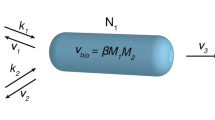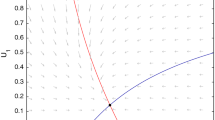Abstract
A consumer-resource reaction-diffusion model with a single consumer species was proposed and experimentally studied by Zhang et al.(Ecol Lett 20:1118-1128, 2017). Analytical study on its dynamics was further performed by He et al.(J Math Biol 78:1605-1636, 2019). In this work, we completely settle the conjecture proposed by He et al.(J Math Biol 78:1605-1636, 2019) about the global dynamics of the consumer-resource model for small yield rate. We then study a multi-species consumer-resource model where all the consumer species compete with each other through depression of the limited resources by consumption and there is no direct competition between them. We show that in this case, all consumer species persist uniformly, which implies that “competition exclusion” phenomenon will never happen. We also clarify its dynamics in both homogeneous and heterogeneous environments under various circumstances.
Similar content being viewed by others
References
Arditi R, Lobry C, Sari T (2015) Is dispersal always beneficial to carrying capacity? New insights from the multi-patch logistic equation. Theor Popul Biol 106:45–59
Cantrell RS, Cosner C (1991) Diffusive logistic equations with indefinite weights: population models in disrupted environments, II. SIAM J Math Anal 22:1043–1064
Cantrell RS, Cosner C (1998) On the effects of spatial heterogeneity on the persistence of interacting species. J Math Biol 37(2):103–145
Cantrell RS, Cosner C (2003) Spatial ecology via reaction-diffusion equations. Wiley Series in Mathematical and Computational Biology. Wiley, Chichester
DeAngelis D, Ni W-M, Zhang B (2016) Dispersal and spatial heterogeneity: single species. J Math Biol 72:239–254
Gause GF (1934) The struggle for existence, baltimore. Williams and Wilkins Co., Maryland
Guo Q, He X, Ni W-M (2020) On the effects of carrying capacity and intrinsic growth rate on single and multiple species in spatially heterogeneous environments. J Math Biol 81:403–433
Guo Q, He X, Ni W-M (2020) Global dynamics Of a general Lotka-Volterra competition-diffusion system in heterogeneous environment. Discrete Contin Dyn Syst 40:6547–6573
Hess P (1991) Periodic-parabolic boundary value problems and positivity, Pitman Research Notes in Mathematics Series, 247, Longman, Harlow. Wiley, New York
He X, Ni W-M (2013) The effects of diffusion and spatial variation in Lotka-Volterra competition-diffusion system, I: heterogeneity vs. homogeneity. J Diff Eqs 254:528–546
He X, Ni W-M (2013) The effects of diffusion and spatial variation in Lotka-Volterra competition-diffusion system II: the general case. J. Diff. Eqs. 254:4088–4108
He X, Ni W-M (2016) Global dynamics of the Lotka-Volterra competition-diffusion system: diffusion and spatial heterogeneity I. Commun Pure Appl Math 69:981–1014
He X, Ni W-M (2016) Global dynamics of the Lotka-Volterra competition-diffusion system with equal amount of total resources, II. Calc Var Partial Diff Equ 55(2):25, 20
He X, Ni W-M (2017) Global dynamics of the Lotka-Volterra competition-diffusion system with equal amount of total resources, III. Calc Var Partial Diff Equ 56(5):132,26
He X, Lam K-Y, Lou Y, Ni W-M (2019) Dynamics of a consumer-resource reaction-diffusion model: homo- geneous versus heterogeneous environments. J Math Biol 78:1605–1636
Hutchinson GE (1978) An introduction to population ecology. Yale University Press, New Haven
Lam K-Y, Ni W-M (2012) Uniqueness and complete dynamics in the heterogeneous competition-diffusion systems. SIAM J Appl Math 72:1695–1712
León JA, Charlesworth B (1978) Ecological versions of Fisher’s fundamental theorem of natural selection. Ecology 59:457–464
Lotka A (1925) Elements of Physical Biology, Baltimore. Williams & Wilkins, Maryland
Lou Y (2006) On the effects of migration and spatial heterogeneity on single and multiple species. J Diff Eqs 223:400–426
Lou Y (2008) Some challenging mathematical problems in evolution of dispersal and population dynamics, Tutorials in mathematical biosciences, IV, 171–205. Lecture Notes in Mathematics, vol 1922. Springer, Berlin
MacArthur RH (1972) Geographical ecology. Harper and Row, New York
Mallet J (2012) The struggle for existence: how the notion of carrying capacity, K, obscures the links between demography, Darwinian evolution and speciation. Evolut Ecol Res 14:627–665
May RM (1973) Stability and complexity in model ecosystems. Princeton University Press, New Jersy
Mischaikow K, Smith H, Thieme HR (1995) Asymptotically autonomous semiflows: chain recurrence and Lyapunov functions. Transact Am Math Soc 347:1669–1685
Ni W, Shi J, Wang M (2020) Global stability of nonhomogeneous equilibrium solution for the diffusive Lotka-Volterra competition model. Calc Var Partial Diff Eqs 59(4):132, 28
Pao CV (1981) Coexistence and stability of a competition-diffusion system in population dynamics. J marh Anal Appl 83:54–76
Skellam JG (1951) Random dispersal in theoretical populations. Biometrika 38:196–218
Smith HL, Thieme HR (2011) Dynamical systems and population persistence, graduate studies in mathematics, vol 118. American Mathematical Society, Providence, RI
Tilman D (1982) Resource competition and community structure. Princeton University Press, Princeton, NJ
Verhulst P (1838) Notice sur la loi que la population suit dans son accroissement. Correspondance Mathematique et Physique 10:113–121
Volterra V (1927) Variazioni e fluttuazioni del numero d’individui in specie animali conviventi, Regio Comitato Talassografico Italiano. Memoria 131:1–142
Wang M (2018) Note on the lyapunov functional method. Appl Math Lett 75:102–107
Wang Z-A, Xu J (2021) On the Lotka-Volterra competition system with dynamical resources and density-dependent diffusion. J Math Biol 82:7, 37
Yao Ruofei, Li Rui (2023) Dynamics and steady-state analysis of a consumer-resource model. Nonlinear Anal Real World Appl 69:103705, 17
Zhang B, Kula A, Mack K, Zhai L, Ryce A, Ni W-M, DeAngelis D, Van Dyken JD (2017) Carrying capacity in a heterogeneous environment with habitat connectivity. Ecol Lett 20:1118–1128
Zhang B, Lam K-Y, Ni W-M, Signorelli R, Collins KM, Fu Z, Zhai L, Lou Y, DeAngelis DL, Hastings A (2022) Directed movement changes coexistence outcomes in heterogeneous environments. Ecol Lett 25:366–377
Zhou L, Pao CV (1982) Asymptotic behavior of a competition-diffusion system in population dynamics. Nonlinear Anal 6:1163–1184
Acknowledgements
The research of X. He is supported in part by National Key R &D Program of China 2022YFA1004401, NSFC grant No. 12071141 and Science and Technology Commission of Shanghai Municipality (No. 22DZ2229014). The research of W.-M. Ni is partially supported by NSFC grants No. 11431005 and No. 12071141, the Presidential Fund PF1-000923 at CUHK(SZ) and the Shenzhen Municipal Grant No. GXWD20201231105722002. The authors are grateful to the two anonymous referees for their careful and thorough reviews with numerous suggestions, which greatly improve the presentation of this paper.
Author information
Authors and Affiliations
Corresponding author
Additional information
Publisher's Note
Springer Nature remains neutral with regard to jurisdictional claims in published maps and institutional affiliations.
Rights and permissions
Springer Nature or its licensor (e.g. a society or other partner) holds exclusive rights to this article under a publishing agreement with the author(s) or other rightsholder(s); author self-archiving of the accepted manuscript version of this article is solely governed by the terms of such publishing agreement and applicable law.
About this article
Cite this article
He, X., Ni, WM. & Wang, H. Dynamics of consumer-resource reaction-diffusion models: single and multiple consumer species. J. Math. Biol. 87, 39 (2023). https://doi.org/10.1007/s00285-023-01970-0
Received:
Revised:
Accepted:
Published:
DOI: https://doi.org/10.1007/s00285-023-01970-0
Keywords
- Global asymptotic stability
- Reaction-diffusion system
- Consumer-resource model
- Spatial heterogeneity
- Lyapunov function




